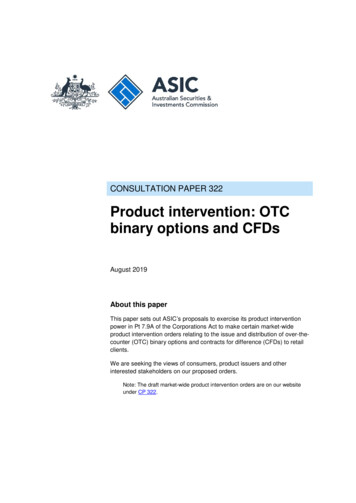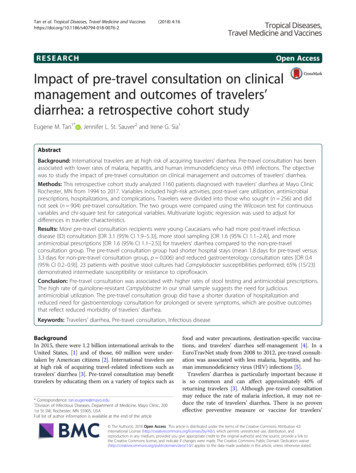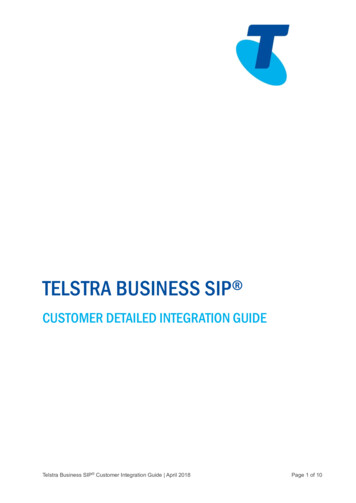
Transcription
CONSULTATION PAPER 322Product intervention: OTCbinary options and CFDsAugust 2019About this paperThis paper sets out ASIC’s proposals to exercise its product interventionpower in Pt 7.9A of the Corporations Act to make certain market-wideproduct intervention orders relating to the issue and distribution of over-thecounter (OTC) binary options and contracts for difference (CFDs) to retailclients.We are seeking the views of consumers, product issuers and otherinterested stakeholders on our proposed orders.Note: The draft market-wide product intervention orders are on our websiteunder CP 322.
CONSULTATION PAPER 322: Product intervention: OTC binary options and CFDsAbout ASIC regulatory documentsIn administering legislation ASIC issues the following types of regulatorydocuments.Consultation papers: seek feedback from stakeholders on matters ASICis considering, such as proposed relief or proposed regulatory guidance.Regulatory guides: give guidance to regulated entities by: explaining when and how ASIC will exercise specific powers underlegislation (primarily the Corporations Act) explaining how ASIC interprets the law describing the principles underlying ASIC’s approach giving practical guidance (e.g. describing the steps of a process suchas applying for a licence or giving practical examples of howregulated entities may decide to meet their obligations).Information sheets: provide concise guidance on a specific process orcompliance issue or an overview of detailed guidance.Reports: describe ASIC compliance or relief activity or the results of aresearch project.Document historyThis paper was issued on 22 August 2019 and is based on the CorporationsAct as at the date of issue.DisclaimerThe proposals, explanations and examples in this paper do not constitutelegal advice. They are also at a preliminary stage only. Our conclusions andviews may change as a result of the comments we receive or as othercircumstances change. Australian Securities and Investments Commission August 2019Page 2
CONSULTATION PAPER 322: Product intervention: OTC binary options and CFDsContentsThe consultation process . 4AOverview . 6Our proposed product intervention . 6Binary options and CFDs in Australia . 6Significant detriment to retail clients from binary options and CFDs . 7International measures in relation to binary options and CFDs. 8Proposed product intervention: Binary options . 8Proposed product intervention: CFDs . 9Our next steps . 9BBinary options and CFDs in Australia .11Binary options . 11Contracts for difference . 12Availability of binary options and CFDs to retail clients . 13CSignificant detriment to retail clients from binary options andCFDs .20Significant detriment to retail clients from binary options . 20Significant detriment to retail clients from CFDs. 24Our regulatory actions to date . 33DInternational measures in relation to binary options and CFDs .34IOSCO’s regulatory toolkit to enhance protections for retail clients 34Measures implemented by foreign regulators on OTC binaryoptions . 36Measures implemented by foreign regulators on OTC CFDs . 37Crypto-asset CFDs . 39Regulatory arbitrage . 39EProposed product intervention: Binary options .41Prohibition on the issue and distribution of binary options to retailclients . 41FProposed product intervention: CFDs .44Imposing certain conditions on the issue and distribution of CFDsto retail clients . 44GRegulatory and financial impact.56Appendix 1: ASIC’s actions in the retail OTC derivatives sector .57Appendix 2: Analysis on setting leverage ratio limits.62Appendix 3: Accessible versions of figures .65Key terms .67List of proposals and questions .69 Australian Securities and Investments Commission August 2019Page 3
CONSULTATION PAPER 322: Product intervention: OTC binary options and CFDsThe consultation processBefore making a product intervention order, we must consult persons whoare reasonably likely to be affected by the order: see s1023F of theCorporations Act 2001 (Corporations Act).You are invited to comment on the proposed product intervention orders inthis paper.We are keen to fully understand and assess the financial and other impactsof our proposed product intervention orders. Therefore, we ask you tocomment on: our identification of the products and their availability for acquisition byissue to retail clients; the significant consumer detriment we have identified; the product intervention orders we propose to make; the likely compliance costs; the likely effect on competition; other impacts, costs and benefits; and the proposed delayed commencement of each order.Where possible, we are seeking both quantitative and qualitative information.Any information about compliance costs, effects on competition and otherimpacts, costs and benefits will be taken into account if we prepare aRegulation Impact Statement: see Section G, ‘Regulatory and financialimpact’.Making a submissionYou may choose to remain anonymous or use an alias when making asubmission. However, if you do remain anonymous we will not be able tocontact you to discuss your submission should we need to.Please note we will not treat your submission as confidential unless youspecifically request that we treat the whole or part of it (such as any personalor financial information) as confidential.Please refer to our privacy policy for more information about how we handlepersonal information, your rights to seek access to and correct personalinformation, and your right to complain about breaches of privacy by ASIC.Comments should be sent by 1 October 2019 to:OTC Intermediary ComplianceMarket SupervisionAustralian Securities and Investments CommissionLevel 7, 120 Collins Street, Melbourne, VIC 3000email: Market.Supervision.OTC@asic.gov.au Australian Securities and Investments Commission August 2019Page 4
CONSULTATION PAPER 322: Product intervention: OTC binary options and CFDsWhat will happen next?Stage 122 August 2019ASIC consultation paper releasedStage 21 October 2019Comments due on the consultation paperStage 3From October2019Consider all comments on the consultationpaper.Consult the Office of Best PracticeRegulation about our analysis of theregulatory impact of our proposals.Decide whether to make product interventionorders in respect of binary options and/orCFDs.Publish on our website notice of any decisionto make a product intervention order and theterms of any product intervention ordermade, including the commencement date. Australian Securities and Investments Commission August 2019Page 5
CONSULTATION PAPER 322: Product intervention: OTC binary options and CFDsAOverviewKey pointsThe Australian retail OTC derivatives sector is growing at a rapid pace.We consider that OTC binary options and CFDs have resulted in, and arelikely in future to result in, significant detriment to retail clients.To address this harm, in this paper we propose to make market-wideproduct intervention orders relating to the issue and distribution of OTCbinary options and CFDs.Our proposals are consistent with product intervention measures in otherjurisdictions.Our proposed product intervention1This paper highlights our concerns that the issue of OTC binary options andCFDs to retail clients in Australia has resulted in, and is likely in future toresult in, significant detriment, including significant financial losses.Note: In this paper, ‘retail client’ has the same meaning as defined in s761A of theCorporations Act.2Under Pt 7.9A of the Corporations Act, ASIC may make a productintervention order when we are satisfied that a financial product available forissue to retail clients has resulted in, or will or is likely to result in,significant detriment to retail clients.3On 26 June 2019, we published Consultation Paper 313 Product interventionpower (CP 313). CP 313 seeks feedback on a draft regulatory guide whichsets out the scope of the product intervention power, when and how weexpect to use the power and how a product intervention order is made. Thefeedback from that consultation process will inform this consultationprocess.4In this paper we propose to exercise our power to make market-wide productintervention orders in relation to OTC binary options and CFDs.Binary options and CFDs in Australia5Binary options are OTC derivatives that allow clients to make ‘all-or-nothing’bets on the occurrence or non-occurrence of a specified event in a definedtimeframe (e.g. the price of gold increasing in 30 seconds). Australian Securities and Investments Commission August 2019Page 6
CONSULTATION PAPER 322: Product intervention: OTC binary options and CFDs6CFDs are leveraged OTC derivatives that allow clients to speculate on thechange in the value of an underlying asset.7ASIC supervises AFS licensees who issue and make a market for binaryoptions and CFDs in or from Australia to retail clients. These products aremarketed by issuers to retail clients, primarily through online marketing andthe use of trading inducements. Issuers also commonly engage third partiesto promote their products to retail clients, but licensed financial advice isuncommon.8The Australian market for binary options and CFDs continues to experiencesignificant growth. Complaints about binary options and CFDs have alsoincreased sharply.Significant detriment to retail clients from binary options and CFDs9We consider that binary options and CFDs have resulted in, and are likely infuture to result in, significant detriment to retail clients, primarily financiallosses. This is because:(a)(b)10for binary options:(i)most retail clients who trade binary options lose money;(ii)there is a negative expected return, resulting in significant marketwide financial losses;(iii)there is a high likelihood of cumulative losses; and(iv)the inherent structural design flaws are confusing and make themunsuitable as an investment or risk management product for retailclients—we find their characteristics are akin to gambling.for CFDs:(i)most retail clients who trade CFDs lose money;(ii)high leverage ratios carry inherent risk of significant losses,including losses which can exceed a retail client’s initialinvestment;(iii)fees and costs lack transparency, are magnified by leverage andcan quickly and significantly deplete a retail client’s investment;and(iv)confusing and unclear pricing methodologies can lead to the sale toretail clients of CFDs that are misaligned with their needs,expectations and understanding.For many years we have taken strong and frequent regulatory action, using arange of regulatory tools, to address our concerns about binary options and Australian Securities and Investments Commission August 2019Page 7
CONSULTATION PAPER 322: Product intervention: OTC binary options and CFDsCFDs: see Appendix 1. However, we consider retail clients continue tosuffer significant detriment from these products.International measures in relation to binary options and CFDs11Our concerns about binary options and CFDs, and the significant detrimentto retail clients resulting from these high-risk products, are not unique to theAustralian market.12The International Organization of Securities Commissions (IOSCO) recentlypublished a toolkit (PDF 988 KB) which is intended to be used by regulatorsto enhance protections for retail clients.13An increasing number of foreign regulators have implemented, or areplanning to implement, measures to prohibit or restrict the offer of binaryoptions and CFDs.14We will continue to closely monitor for ‘regulatory arbitrage’, and otherpotential avoidance practices by issuers which undermine or attempt to workaround the intended purpose of our proposed intervention. If significantconsumer detriment persists we will consider further intervention.Proposed product intervention: Binary options15We propose to make a market-wide product intervention order that prohibits theissue and distribution of OTC binary options to retail clients: see Section E andAttachment 1 (on our website under CP 322).16Binary options, in our view, provide no meaningful investment or economicutility. Unlike other types of OTC derivatives or exchange traded products,binary options do not offer participation in the growth in value of theunderlying asset. The typical ‘all-or-nothing’ payoff structure of binaryoptions also makes them unsuitable for risk management arrangements suchas hedging.17The proposed product intervention order addresses our concerns about theinherent risks of binary options by removing the possibility for retail clientsto trade them and to make losses.18Our proposed intervention is also consistent with measures taken in otherjurisdictions. Australian Securities and Investments Commission August 2019Page 8
CONSULTATION PAPER 322: Product intervention: OTC binary options and CFDsProposed product intervention: CFDs19We propose to make a market-wide product intervention order that imposescertain conditions on the issue and distribution of OTC CFDs to retailclients: see Section F, Attachment 2 (on our website under CP 322) andAppendix 2.20Unlike binary options, CFDs can serve legitimate trading, investment andhedging purposes. However, it is concerning that most retail clients losemoney trading CFDs, often due to excessive leverage. Unclear or confusingpresentation of information to retail clients about the risks, pricing and costsof CFD trading can lead to the sale of CFDs that are misaligned with clients’needs, expectations and understanding.21The proposed product intervention order conditions relating to CFDs would:(a)impose CFD leverage ratio limits (Condition 1);(b)implement a standardised approach to the automatic close-out of retailclient positions (Condition 2);(c)protect against negative balances (Condition 3);(d)prohibit the offer of certain inducements in relation to CFDs (Condition 4);and(e)require enhanced transparency of CFD pricing, execution, costs andrisks (Conditions 5–8).22Condition 6 (real-time disclosure of total position size) and Condition 7(real-time disclosure of overnight funding costs) address additional concernswe have identified in our surveillance activities. If implemented, it is ourunderstanding that Australia will be the first jurisdiction to introduce productintervention measures of this nature.23Our proposed intervention is otherwise consistent with measures taken inother jurisdictions.Our next steps24This consultation paper should not be construed as an indication that wehave made a final decision on exercising our product intervention power. Afinal decision will be made once we have considered the feedback to ourproposals. Similarly, the terms of any final product intervention orders maychange, depending on feedback and any further information we receive.25Our proposals in this paper apply to OTC binary options and CFDs.However, there are also other leveraged financial products—traded OTC oron an exchange—which are issued to retail clients and which exhibit similarcharacteristics or risks. Australian Securities and Investments Commission August 2019Page 9
CONSULTATION PAPER 322: Product intervention: OTC binary options and CFDs26We continue to consider potential future market-wide product interventionorders which, for example, could impose certain conditions (such as leverageratio limits) on a broader range of financial products offered to retail clients.Any future proposed orders would be subject to a separate consultationprocess. Australian Securities and Investments Commission August 2019Page 10
CONSULTATION PAPER 322: Product intervention: OTC binary options and CFDsBBinary options and CFDs in AustraliaKey pointsBinary options are OTC derivatives that allow clients to bet on theoccurrence or non-occurrence of a specified event in a defined timeframe,such as an increase in the price of an underlying asset.CFDs are leveraged OTC derivatives that allow clients to speculate on thechange in the value of an underlying asset. ‘Margin FX’ is a popular CFDthat references currency pairs.Binary options and CFDs are available for acquisition by issue to retailclients in Australia.ASIC supervises AFS licensees who issue and make a market for binaryoptions and CFDs in or from Australia to retail clients.Our analysis shows that the Australian market for these products continuesto experience significant growth, particularly in client numbers, transactionvolume and gross annual turnover.Binary options27Binary options are OTC derivatives that allow clients to bet on theoccurrence or non-occurrence of a specified event in a defined timeframe.This can include a bet on movements in the price of a financial product, amarket index or an economic event (such as central bank interest ratedecisions).28‘Over-the-counter’ or ‘OTC’ means that the derivatives are transactedbetween two counterparties (being the issuer of the derivative and the client),not on an exchange. In Australia, binary options and CFDs are currently onlytraded OTC.29The term ‘binary’ illustrates the typical ‘all-or-nothing’ payout structure ofbinary options. If the bet made by the client in relation to the specified eventis correct, the retail client ‘wins’ (i.e. the client receives a predeterminedcash payout, less any fees and costs). If the bet on the event is not correct,the client ‘loses’ (i.e. the client loses their investment amount, plus any feesand costs).30For example, an ‘up/down’ binary option is a bet on whether the price of anunderlying asset will go up or down over a specified period. Australian Securities and Investments Commission August 2019Page 11
CONSULTATION PAPER 322: Product intervention: OTC binary options and CFDs31The predetermined cash payout for a ‘winning’ binary options contract issometimes expressed as a dollar figure (e.g. 180) or a profit as a percentageof the investment amount (e.g. 80% of the investment amount).32Binary options typically have a short-term contract duration. For example,some issuers offer binary options to retail clients with a contract duration ofonly 30 seconds.33The minimum investment amount to enter into a binary options contract canbe minimal—as small as 10. Binary options issuers may also chargeadditional fees and costs, such as commission costs.34Binary options are often marketed by issuers under different names ordescriptions. Examples include ‘all-or-nothing options’, ‘fixed returnoptions’, ‘digital options’ and ‘countdowns’. For the purposes of this paperand Proposal E1 our reference to ‘binary options’ is intended to capture allderivatives that fall within our proposed definition, however named ordescribed.Note: See the definition of ‘binary option’ in our proposed product intervention order inAttachment 1 (on our website under CP 322).35There are five licensed issuers of binary options in Australia. We understandthat some other AFS licensees have ceased offering binary options due tostrong regulatory interventions in other jurisdictions: see Table 3.Contracts for difference36CFDs are leveraged OTC derivatives that allow clients to speculate on thechange in the value of an underlying asset. This can include currency pairs(such as AUD/USD) which are also known as ‘margin foreign exchange’ or‘margin FX’ and are the most commonly traded type of CFD in Australia.Other underlying assets include equity indices, single equities, commodities,crypto-assets (e.g. Bitcoin), interest rate instruments, futures and options.Note: Crypto-asset CFDs are relatively new but growing quickly in Australia. We haveidentified 35 issuers that offer crypto-asset CFDs in or from Australia to retail clients.37Clients can open a ‘long’ or ‘short’ CFD position. A long position meansentering into a CFD contract with the expectation that the underlying assetwill increase in value. A short position means entering into a CFD contractwith the expectation that the underlying asset will decrease in value.38In both cases, when a client closes their CFD position, their profit or loss isthe difference between the closing value and the opening value of their CFDposition (including any fees and other costs such as interest charges onpositions held overnight). Clients are effectively betting on whether the Australian Securities and Investments Commission August 2019Page 12
CONSULTATION PAPER 322: Product intervention: OTC binary options and CFDsvalue of the underlying asset is going to rise or fall in the future, comparedto the value when the CFD contract is opened.39Unlike binary options, CFDs are typically leveraged. This enables clients touse a small initial investment (known as ‘margin’) to gain exposure to anasset for a proportion of that asset’s value. For example, for a CFD contractwith a leverage ratio of 200:1, a client would only have to deposit an initialmargin of 5,000 to gain economic exposure of 1 million to theperformance of the underlying asset. The client is effectively in a similarposition to borrowing the other 99.5% of the value of the underlying asset ofthe CFD.40A client does not own the underlying asset of a CFD. Instead, CFDs onlygive clients indirect exposure to the underlying asset of the CFD.41For the purposes of this paper and Proposal F1 our reference to ‘CFDs’ isintended to capture all derivatives that fall within our proposed definition.Note: See the definition of ‘CFD’ in our proposed product intervention order inAttachment 2 (on our website under CP 322).Availability of binary options and CFDs to retail clientsOur 2017 and 2019 reviews of the sector42In 2017 we conducted a review of the size and nature of the Australianmarket for binary options and CFDs (2017 review).43Our 2017 review was based on data collected from 57 AFS licensees thatwere actively issuing binary options or CFDs (or both) in or from Australiato retail clients. Issuers were asked to provide us with data for any 12-monthperiod between 1 January 2016 and 30 June 2017.44In June 2018, we published Report 579 Improving practices in the retailOTC derivatives sector (REP 579), which reported on the results of our2017 review.45This year we undertook a subsequent analysis of the Australian retail OTCderivatives market (2019 review).46Our 2019 review was based on data collected from 61 AFS licensees thatwere actively issuing binary options or CFDs (or both) in or from Australiato retail clients. Issuers were asked to provide us with data for the period1 January 2018 to 31 December 2018. In some instances, we asked issuers toprovide us with data as at 31 March 2019 (e.g. number of clients). Australian Securities and Investments Commission August 2019Page 13
CONSULTATION PAPER 322: Product intervention: OTC binary options and CFDsRetail OTC derivatives issuers and product distribution47ASIC is responsible for the regulation and supervision of AFS licensees whoissue and make a market for binary options and CFDs in or from Australia toretail clients.48We have identified 65 AFS licensees, as at 1 August 2019, who issue binaryoptions or CFDs in or from Australia to retail clients.49A common distribution practice which we have observed is the use byissuers of third parties (referrers) that refer potential new retail clients to theissuer. Referrers may include ‘authorised representatives’, ‘affiliates’,‘introducing brokers’ or existing retail clients. In return, referrers commonlyreceive some form of remuneration from the issuer. We have heard fromsome retail client reports that referrers have approached them in chat rooms,dating sites, through mainstream social media and taxi cabs.Note: We discuss referral arrangements in more detail in REP 579.50In our 2019 review we found that issuers had arrangements with over 60,000referrers in aggregate. Of these, 92% of referral arrangements provide forremuneration based on client trading volumes. In 2018, issuers paid over 281 million in remuneration to referrers.Growth in the Australian market51The size of the Australian market for binary options and CFDs has grownconsiderably over recent years through the increase in the number of clientsand transactions, as well as gross annual turnover.52Figure 1 illustrates the growth in the sector between our 2017 and 2019reviews. Of the 675 million transactions reported in our 2019 review,approximately 79% were in CFDs and the remaining 21% were in binaryoptions. This compares to approximately 85% and 15% respectively in our2017 review. Australian Securities and Investments Commission August 2019Page 14
CONSULTATION PAPER 322: Product intervention: OTC binary options and CFDsFigure 1: Growth in the Australian market for binary options and CFDs between our 2017 and2019 reviewsNote: Gross annual turnover is the total position value of all client trades in binary options and CFDs that are processed byAFS licensees. Client funds and number of transactions are for retail and wholesale clients.Client demographics53Data we gathered from issuers licensed in Australia shows that binaryoptions and CFDs are generally marketed to, and traded by, retail clients.54As at 31 March 2019, 99% of binary options and CFD issuers’ clients wereretail clients.55Surprisingly, as at 31 March 2019, clients based in Australia accounted forjust 17% of the approximately 1 million clients of binary options and CFDissuers identified in our 2019 review. The largest percentage of clients (62%)were based in Asia, one-third of which (21% of total clients) were based inChina: see Figure 2. Australian Securities and Investments Commission August 2019Page 15
CONSULTATION PAPER 322: Product intervention: OTC binary options and CFDsFigure 2: Distribution of binary options and CFD clients by jurisdictionSouth America, 3%North America, 3%Africa, 4%Asia ex re 3 and Figure 4 show the age groups and income levels of clients ofbinary options and CFD issuers, reported to us in anonymised form in our2019 review.% of clients in age rangeFigure 3: Age groups of binary option and CFD clients by percentage(as at 31 March 2019)48%32%11%6%3%18–215722–3031–50Age range51–6465 Figure 3 shows that 80% of clients were in the 22–50 years age group, withnearly half of all clients aged between 31 and 50 years as at 31 March 2019.Fourteen percent of clients were aged over 50. Australian Securities and Investments Commission August 2019Page 16
CONSULTATION PAPER 322: Product intervention: OTC binary options and CFDsFigure 4: Income levels of binary options and CFD clients bypercentage (as at 31 March 2019)% of clients in income range37%22%20%11%10%Income range58Figure 4 shows that close to 70% of clients earn an annual income of 80,000 or less, which is roughly the median full-time income in Australia.Notably, 32% of all clients had an annual income of 37,000 or less.Marketing practices59Many retail clients do not seek or receive financial advice before deciding totrade binary options or CFDs, instead relying on advertising, social mediaand the internet for information.60In our 2019 review, binary options and CFD issuers reported that theiraggregate annual marketing expenses increased by 40% from 93 millionin 2017 to 131 million in 2018, while there was no material change in thenumber of issuers.61We have observed the aggressive marketing practices used by CFD issuersover many years. They are used to attract new clients as well as to enticeexisting clients to trade more. We have received reports from industrystakeholders that there is a significant turnover or ‘churn’ of retail clients,and some issuers are heavily reliant on aggressive marketing techniques toattract new retail clients.62Issuers reported that in 2017 and 2018 over 225,000 new clients were giveninducements to open an account to trade binary options or CFDs. Australian Securities and Investments Commission August 2019Page 17
CONSULTATION PAPER 322: Product intervention: OTC binary options and CFDsExamples of inducements‘Free’ giftWe have observed CFD issuers offering a ‘free’ gift (e.g. a tablet computer)on the condition that the client takes a certain number of CFD positions,which ultimately ends up costing more than the gift itself. This is particularlyconcerning given evidence which suggests the risk of losing is amplifiedwith more frequent trading.Bonus creditsWe have seen instances of bonus credits being offered to existing clientswho have received a margin call and need to deposit m
Complaints about binary options and CFDs have also increased sharply. Significant detriment to retail clients from binary options and CFDs 9 We consider that binary options and CFDs have resulted in, and are likely in future to result in, significant detriment to retail clients, primarily financial losses. This is because: (a) for binary .










